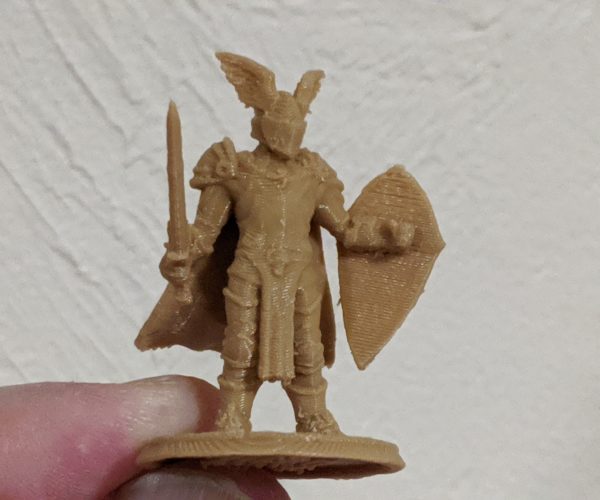Prusa Slicer supports too unstable for 0.25mm nozzle
I recently switched to a 0.25mm nozzle and started printing a few miniatures at 0.07mm layer height. However, I’m finding that Prusa Slicer standard supports are too flimsy and will fail somewhere most of the time. I changed to Cura using ZigZag supports and haven’t had a failure since. I generally didn’t have this problem with Slicer when using a 0.4mm nozzle, although I was mostly printing more solid and somewhat less complex objects than miniatures. I did have one failure at 0.4mm where Slicer made an isolated supported tower that started to wobble, but generally supports were working. Has anyone gotten Slicer supports to work with 0.25 nozzle? Should I maybe using a different support pattern? Any other setting I should change?
RE: Prusa Slicer supports too unstable for 0.25mm nozzle
I've printed miniatures with supports using a 0.25mm nozzle using PrusaSlicer without too much trouble. When you say the supports fail, how do they fail? I've found that bed adhesion is key. Cura lays down a bit of a raft under supports if I recall correctly, whereas PrusaSlicer does not and does not appear to provide an option to do so. This will matter if adhesion is the issue. If you've got your PEI print surface cleaned properly, even fine support should hold well. Here's what I'm getting with PETG printing with a 0.25mm nozzle:

If your supports aren't laying down this cleanly, definitely give your print surface a clean and be sure that your Live-Z is properly calibrated.
Give us a bit more detail on exactly what's failing and we might be able to provide more info.
and miscellaneous other tech projects
He is intelligent, but not experienced. His pattern indicates two dimensional thinking. -- Spock in Star Trek: The Wrath of Khan
RE: Prusa Slicer supports too unstable for 0.25mm nozzle
@bobstro
Hi Bobstro. I've seen a couple of failure modes. The supports don't typically come-off the build plate (in fact many of the supports that fail are sitting on the miniature base, not the buildplate), but either a) the part sitting on the support is not sufficiently adhered to it and falls off (this is the case when there's a small disconnected portion of the miniature that would get connected to the bulk at a higher layer) or b) the support itself will start to wobble causing poor print and blobbing in that area. It may also be possible that b) causes a). I tried both 0.1mm and 0.2mm Contact z distance and have also tried turning on Interface layers (which are off by default for 0.25mm nozzle in Slicer).
I do find that Slicer supports are much easier to remove than the Cura supports. Maybe that's part of the issue in that poor adhesion of supports to the model cause parts to fall off or supports to get bumped by the nozzle movement.
RE: Prusa Slicer supports too unstable for 0.25mm nozzle
Some additional information. I'm printing PLA at 200C and using 0.15mm "Lift Z".
RE: Prusa Slicer supports too unstable for 0.25mm nozzle
Try to reduce unnecessary nozzle movement.
Z-hop/lift is really only necessary to avoid scarring on large horizontal surfaces. You can probably disable it.
Try slowing way down. Dial speed back with the front knob mid-print. Try 50%. If that helps, check support speeds. Also try lower acceleration and jerk settings.
Over-extrusion makes life difficult. Make sure you've calibrated your filament diameter and extrusion multiplier.
There's a fine balance between good adhesion and removable supports. I don't think PrusaSlicer allows different top and bottom z distance (on mobile ATM).
Thin layers can be tricky. How does 0.10mm work? Is there a big difference in appearance?
And of course, try to minimize supports with part orientation.
That's all that comes to mind offhand. I'm no expert with miniatures, but I've done 1:100 armor with a 0.25mm nozzle with good results. I'm a big fan of PrusaSlicer, but Cura's insane level of options is well suited to one-off detailed prints. It may be the best tool for the job.
and miscellaneous other tech projects
He is intelligent, but not experienced. His pattern indicates two dimensional thinking. -- Spock in Star Trek: The Wrath of Khan
RE: Prusa Slicer supports too unstable for 0.25mm nozzle
@mdaneman - I finally had some time near my printer and tried out some recommendations for figures with PrusaSlicer that seem to have worked:
Inland PLA, 205/200 nozzle & 55/55 bed with a 0.25mm nozzle. 0.15mm layer heights, 15% infill & 2 shells. The magic seems to be printing at 45 degrees using a 3mm pattern spacing with 5 interface layers and 0.25mm contact z distance. I normally snapped the helmet wings, loin cloth or cape off removing normal support settings, so this is a big improvement for me.
and miscellaneous other tech projects
He is intelligent, but not experienced. His pattern indicates two dimensional thinking. -- Spock in Star Trek: The Wrath of Khan
RE: Prusa Slicer supports too unstable for 0.25mm nozzle
@bobstro
Hmm. 5 interface layers? Interesting. I have so far only tried zero and one. I have also used 1mm pattern spacing, but I guess that would only make the supports more stable. I'm also using 0.07mm layer height (gives me better detail), so that may have an effect too.
I do already use 40deg support angle (for PS this angle is measured from the vertical, so it's actually 60deg overhang). I did an overhang test before and 60deg overhangs looked pretty good.
I'll try playing with interface layers and see how it goes.
Thanks.
